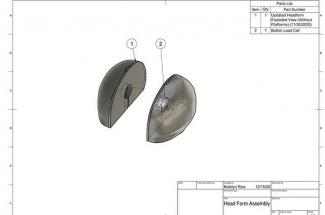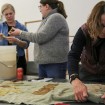UK Students Working to Develop Safety Standard for Equestrian Helmets

University of Kentucky students are working to develop a helmet testing method and collect data that will hopefully serve as the start of a crushing-safety standard for equestrian helmets.
Crushing accidents, while rare, occur when the rider falls from the horse and the horse either steps on or falls on top of the rider’s head. While equestrian helmets certified according to ASTM standards protect riders in a variety of ways, there is no test in place to evaluate a helmet’s crush resistance.
Students Stuart Nicholas from Covington, Sam Gilbert from Corbin and Katelyn Rice from Shelbyville are working to develop a helmet testing method as part of their senior capstone design course in the UK Department of Biosystems and Agricultural Engineering. All are interested in pursuing careers in the medical industry after graduation. Their instructors are Alicia Modenbach and Mick Peterson, lecturer and professor, respectively, in the UK College of Agriculture, Food and Environment. Stephanie Bonin, a senior biomedical engineer with MEA Forensic in Laguna Hills, California, is advising them.
“Biosystems engineering blends biology with engineering principles to design solutions for living systems,” Modenbach said. “Many of our students have an interest in medical school, veterinary school or other biomedical applications of engineering. It is invaluable to them to have the opportunity to work closely with a local industry like the equestrian industry. Projects like this one integrates engineering design with many of their career interests.”
Nicholas said he was interested in the project, because it is related to biomedical engineering, which is his minor and the field of study he plans to pursue in graduate school.
“Since the project requires researching biological properties of the head and skull to develop an accurate model headform, it is an engineering problem that relates to the human body,” he said.
To help fund their project, the students applied for and received a project award from ASTM International, which develops safety standards for materials, products, systems and services. Modenbach said the students are the first who have applied for and received outside funding for their project, since she began teaching the senior capstone class.
Students began working on the project during the fall semester by researching the frequency and severity of equestrian crushing accidents, designing a headform to fit into a helmet for testing, and developing sensors to record lateral forces applied to the headform. The students are building and testing their headform design during the spring semester.
“Helmet standards need to rely on both field and laboratory test data. In order to develop a compression test protocol and acceptance criteria, we need to test helmets at load rates that represent crushing scenarios in the field while recording headform forces. The headform forces will be compared to published injury tolerance data,” said Bonin, who is also chair of the ASTM Equestrian Helmet Committee.
“Our goal for the project will be to have a functioning headform equipped for providing real-time force data when tested on equestrian helmets and to develop a testing protocol that is based on actual injuries riders may face during equestrian events, such as getting crushed by a horse after a fall,” Nicholas said. “This project is the first step in the creation of an ASTM standard, as it will take many more years and research projects to reach this goal, but we hope our project shows the need for a lateral crushing standard for equestrian helmets.”
The students will present the results of their project at the end of the semester and submit a final report to ASTM.


